Halcyon Days in the Dream City
by Mrs. D. C. Taylor
Continued from Part 14

What is “Art?”
Perhaps we are not qualified to say, but to us, “It” is “Truth.” Not merely truth of detail in drawing; though that is necessary to a finished picture, not merely truth of coloring; though that also, must be had, but truth in its highest sense. When a man stands near to the great heart of all, when he sees the meaning of beauties of form and color; when the floating cloud, the calm of evening, the flush of autumn, unfold themselves as speaking from the great source of all, then he becomes an instrument in the hand of God, to speak the truth through form and color. Imitation is not art. Realism attempts to imitate the inimitable, for though a picture may be so cunningly painted that to the eye the illusion may be almost complete, the soul that animates cannot be painted, and realism ceases to be real.
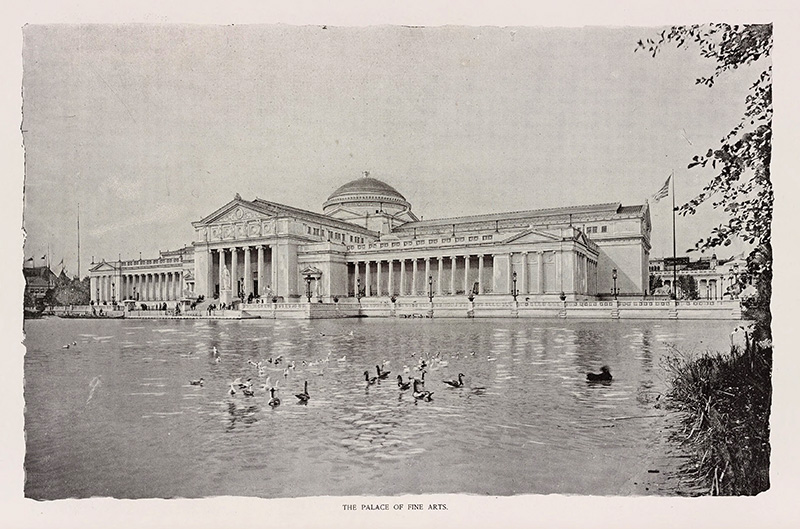
The Palace of Fine Arts south entrance. [Image from The Graphic History of the Fair. Graphic Co., 1894.]
The true artist sees the moral beauty that is the foundation of art; in the depths of his soul feels its true meaning, and seeks to express it by the aid of his brush, as the poet, looking upon the same scene, would seek to express his interpretation with his pen. Art does not reproduce beauty, it interprets its meaning. True beauty is a reflection of the infinite; every work of art elevates, turns the soul away from earth; draws heavenward. A man may paint a picture nearly perfect in execution, that speaks to the lower instincts only, that draws downward; he is a skilful [sic] painter only, he is not an artist; he has not drawn near to truth. The sole object of art is the beautiful. Pictures of bloodshed and sensuality are imitations only; goodness and truth are the foundations of all beauty. People who make no pretense of artistic knowledge, often illustrate this by their mode of speaking when looking at pictures. Of a scene of horror or sensuality they say “that is splendid,” or “that is perfect,” but seldom “that is beautiful” or “that is good.” Some simple bit of sky, field and wood, may have more art in it, than a painting forty feet square, covered every inch of it, with miracles of skill in depicting figures, draperies, furniture and flowers.
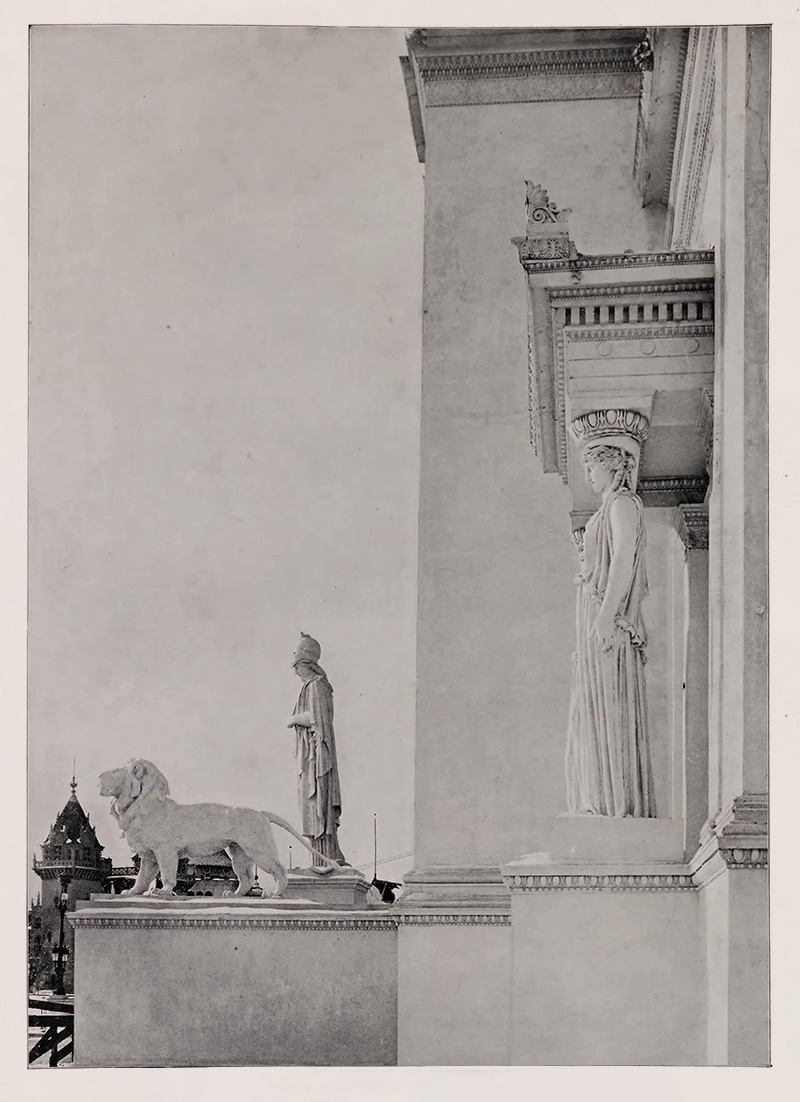
The main entrance of the Palace of Fine Arts. [Image from Unsere Weltausstellung. Eine Beschreibung der Columbischen Weltausstellung in Chicago, 1893. Fred. Klein Co. 1894.]
Side by side, in the Russian exhibit at the Art palace, hang two paintings that forcibly illustrate this theory. One covers fully forty feet of canvas, is crowded with human figures, good drawing, coloring, action, composition, yet! an utter blank. Nothing in the picture tells the story of what the people are about to do, or what emotions are supposed to animate them; it stirs no feeling, it says nothing. Beside this hangs a modest square of canvas, comprising perhaps, as many inches as the other covers square feet. Merely a gray and softly clouded sky, a stretch of gray green waves, a group of rocks and some weather beaten boats drawn up on the sands in the foreground. All gray green, or green gray, excepting where one brilliant shaft of light shoots from the clouds, and strikes out a glittering path across the water. That is all! gray green and a dash of light, but the whole thing with the subtle charm, the delicate beauty, the divine calm and solemn grandeur of nature in her finest moods. It holds the gazer long, it speaks to the soul, it speaks of
God and there is art.
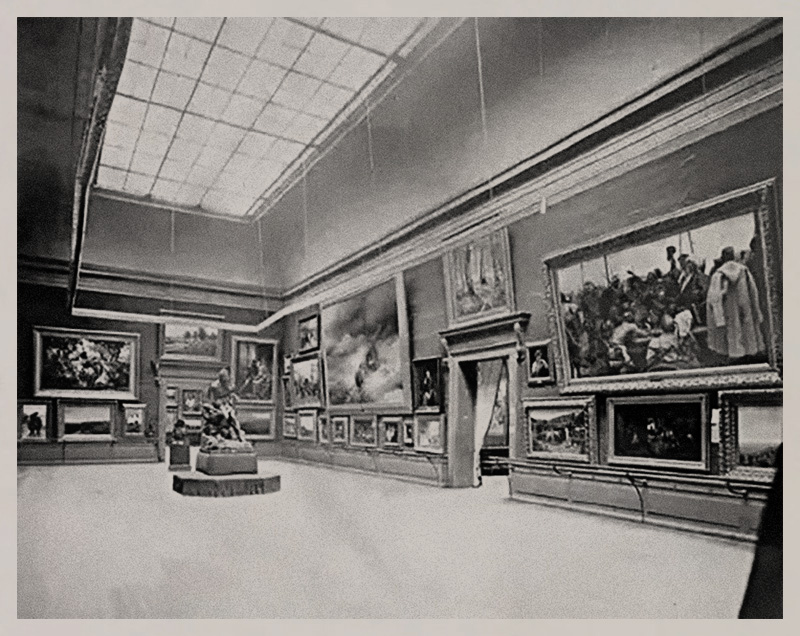
Russian section of the Palace of Fine Arts.
“Beauty has no bounds save in the soul of man” “Art addresses the soul through the body, but not all the senses convey the true idea. Sight and hearing stand eminent as the exponents of truth and the idea! When man sees beauty he feels not only admiration, but emotions of a higher nature; sympathy, tenderness, awe, love, all are aroused by the beautiful, the true, constitute art; all else is imitation. “A true appreciation of beauty awakens no desire for possession; it rouses the soul to enthusiasm but never wakes the passions.” Art is pure; art is holy; art is love of the divine. Art is divine! a spark caught from the eternal principle of all love; all beauty; all truth. Art is eternal! The soul of the true artist will seek and learn through all eternity; as he can never comprehend the all of God, so he can never comprehend the all of art, ever seeking, ever finding, will pass through endless life to endless joys. Here then, we stand upon the threshold of art’s temple; fit temple for the grand spirit to which it is dedicated. See! here it stands, vast, broad, pure, majestic, solemn as the tomb, yet breathing of the joy of life; the stately figures bearing up the fretted cornice, are full of a calm grand strength.
Go up this long broad flight of steps, see those vast portals, inviting you to enter; simple to severity, yet beautiful. Enter! Art takes you to her bosom; wraps you in a mantle of holy awe, steeps you in joy, fills your soul with divine ecstasy. “Look!” she says, “here are my treasures!” here brother speaks to brother! here soul meets soul in higher understanding.” If you are mine then I am yours; all these long aisles hold out their treasured gifts of soul and heart to you; if ye have eyes, ye shall see, but if ye are blind, ’tis but a blank and hollow waste. Bringing nothing with you, ye shall take nothing away; but if you are worthy, rich and full shall be the measure I will mete unto you.” Note, none but the light from above shines into this temple! no EARTH reflections are admitted they mar the beauty of these pictured thoughts. We stand in a vast, domed hall peopled with sculptured dreams. Purity, grandeur, love, joy, hope, grief, despair, every emotion and aspiration that the soul can feel is caught, imprisoned, speaks in the white silent forms. From the tiny smiling infant bust, to the heroic warrior of gigantic form, each is perfect. On either hand are richly draped archways bearing the names of different countries, and through each can be seen long vistas, each one the outward impress of the artists’ best thought and most earnest effort. Shall we seek to tell what we saw in days and days of wandering these corridors?
Of a few pictures we must speak! One named “Orpheus” by Solomon Solomon, enchained, not so much the eye, as the mind; a beautiful youth stands upon a broad rock striking his lyre and singing.[1] At his feet lies a lovely woman sleeping. her long red gold hair in a tumbled mass; around her naked limbs is coiled an immense, irridescent [
sic] serpent, his head lying on the ground at Orpheus feet; the serpent sleeps. Behind the youth is dimly seen a dead body, and beside it sits a vulture with drooping wings; just rising above the edge of the rock is the gray head and careworn face of an old man, his eyes upturned to Orpheus’ face. In the distance a dark sky shows a few faint streaks of dawn, and the light just touches a cross on the summit of a church spire. High in the air are two angels, male and female, clasped in each others arms, their wide white wings just touched with rosy light, and gauzy, floating robes; they bend to listen. Beauty and sensuality forget their wiles and sleep, the serpent of sin ceases to charm and lies quiet; the angels of love bend from heaven to listen; man rises out of the world’s abyss, while the cross points solemnly to the light of heaven dawning upon a darkened world, Unheeding all Orpheus sings on; he is the ever young spirit of harmony, and harmony is
God.
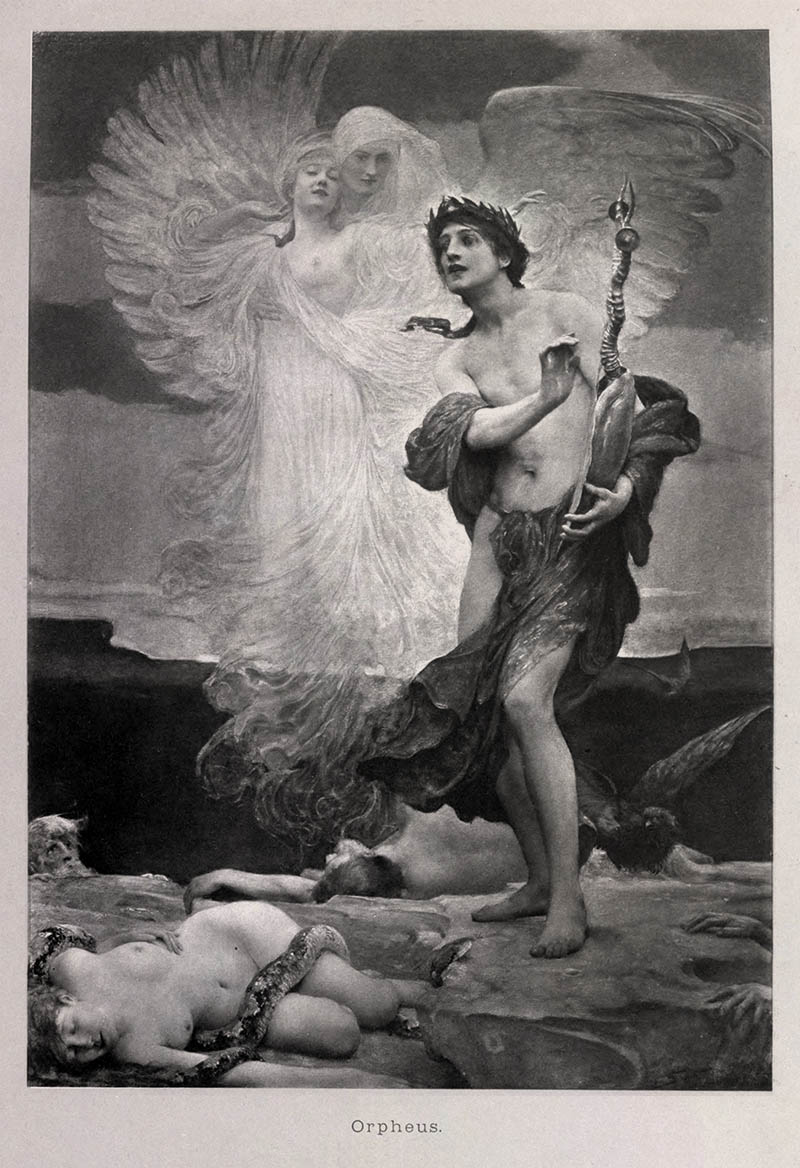
Orpheus by Solomon Joseph Solomon. [Image from Die Kunst unserer Zeit; eine Chronik des modernen Kunstlebens. F. Hanfstaengl, n.d.]
Another picture that held an allegory, was named “At The Magicians Door,” by Riviere Briton, a simple subject at first sight, but holding a deeper meaning to eyes that looked beneath the surface.[2] In the foreground some cracked and worn stone steps, and chained on either side two leopards, with fierce eyes and velvet spotted coats; beyond them still other steps, smooth and unbroken, and beyond
them an arched doorway, the dark drapery of which is drawn aside showing nothing but a shadowy gloom within; and a hanging lamp casts a dim blue light upon the doorstone. What a depth of meaning here! He who dares to leave the well worn path, who seeks to pierce beyond the veil of common thought and belief, will find himself confronted by the savage beasts of hatted and animal sense. But the beasts are
chained; and he who goes bravely forward, will pass in safety where they cannot follow. Few pass beyond! The path is unworn and smooth, and even after those grim sentinels are passed the light is dim, the veil hangs low, he catches but a glimpse beyond for mortal eyes are weak. But, the immortal spirit longs; and he whose hand has written his story upon this canvas, shall surely reach the light for which he seeks.
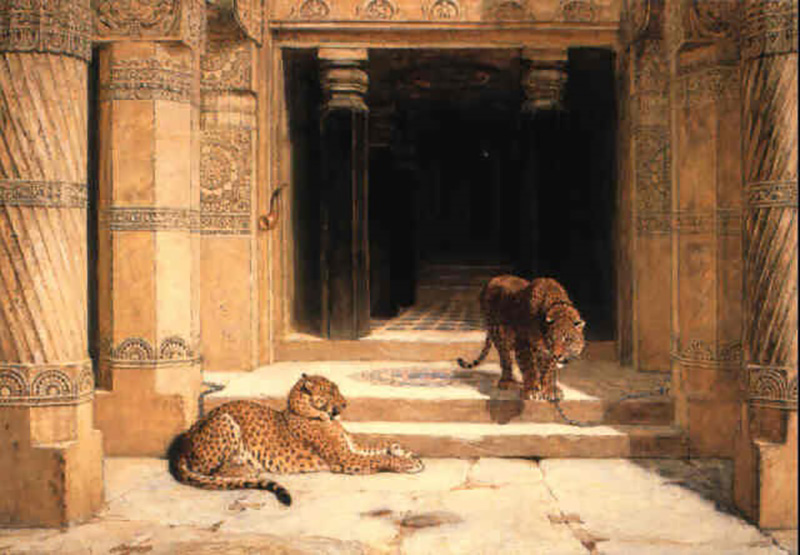
The Magicians Doorway (1882) by Briton Rivière. [Image from Artnet.com.]
“Of Such Is The Kingdom of Heaven,” by Frank Bramley, has a tender charm and feeling that holds the observer long.[3] Four young girls simply dressed in white, bearing an infant’s white coffin, slung in bands of white ribbon. Preceding them a procession of little girls singing, with open books in their hands upon which their eyes are fixed; following the coffin bearers comes the weeping mother, her face buried in a handkerchief, the father beside her; to the left the sea and quay, and a group of fishwives. One bare-headed, bare-footed mother clasps the infant closely to her breast, while an old grandmother, withered and worn, holds a larger child, and both women gaze with sadly sympathetic eyes at the bereaved mother. On the right, a group of rough fishermen gaze solemnly at the procession, while in the immediate foreground several ragged, half grown boys and girls, have paused for a moment in idle and unfeeling curiosity. The picture is very low in tone, the only touches of positive color being in yellow Chrysanthemums among the white flowers with which the coffin is wreathed, but the coloring is pure and the shading delicate. There is a simple truth and pathos about the whole composition. It is the common story of love and loss simply told, nothing is ideal; homely lives, and people common place and plain, but touched with the light of human love and sympathy.
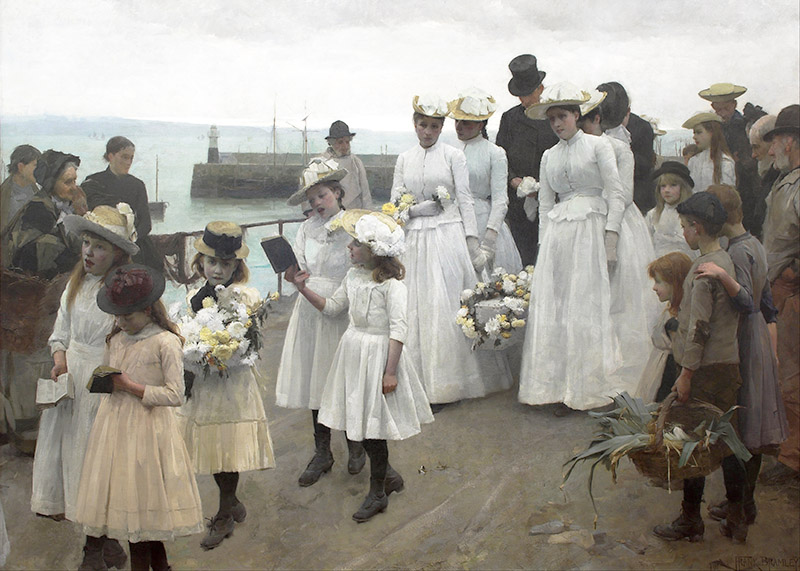
For of Such is the Kingdom of Heaven (1891) by Frank Bramley. [Image from Wikipedia Commons.]
Ripening “Sunbeams,” by Vicat Cole, is an immense canvas.[4] A harvest field, with shocks of yellow wheat, and loose straw scattered over the yellow stubble. Woods yellowing in the summer heat, and in the distance, reapers, and wains loaded with the ripe grain. It is late in the afternoon, and the golden sunlight lies level over all. Everything is golden in tone, even the greens being of that cast, and the whole palpitating with summer heat. Grain ripe for the sickle, foliage ripening to its fall, sunbeams ripening to their setting. Fine! These are but a few out of the unnumbered treasures of thought and feeling, spoken through the skillful brush, by many artists, from many lands. As we look our heart’s swell with joy, for they show that in spite of earth’s taints man ever reaches heavenward. Hour after hour, day after day, we wandered through those endless quiet halls, seeing ever before us a long, long perspective of treasures large and small enticing us ever onward, while the silent throng move with us through the hushed and solemn atmosphere of art. Oh! Well we remember our last visit there. How we wandered sadly from room to room, taking a farewell look at each favorite scene. The pictured eyes seemed to return our sad gaze, the sunny landscapes took on a tinge of melancholy, and still we lingered ’till the chill breath of evening bade us depart.
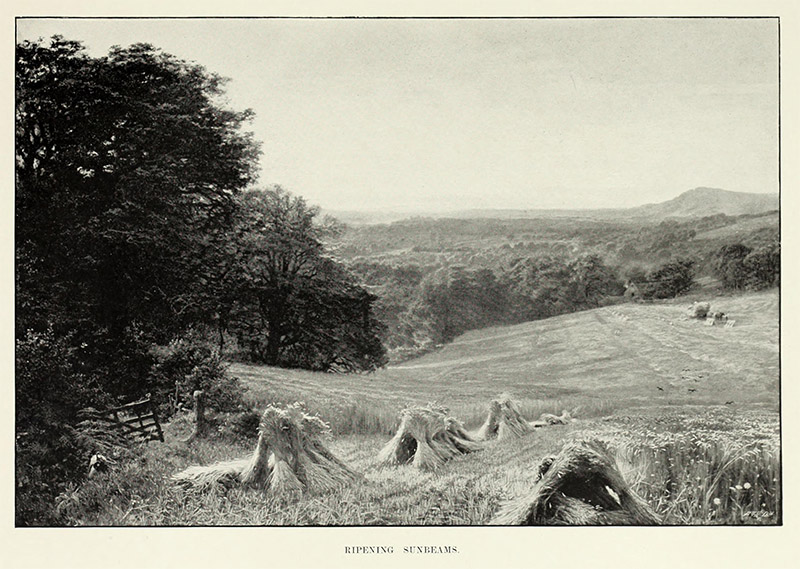
Ripening Sunbeams (1879) by Vicat Cole. [Image from Chignell, Robert The Life and Paintings of Vicat Cole, R. A. Cassell and Co., 1898.]
We left them to return no more! left the great white temple guarding its treasures, and brooding over the reflection of its own matchless beauty, in the motionless mirror of the lagoon.
Continued in Part 16
NOTES
[1] Orpheus by Solomon Joseph Solomon (1860–1927) hung in the British section, Gallery 15.
[2] The title of this oil painting by Briton Rivière (1840–1920) of London is The Magicians Doorway. It hung in the British section, Gallery 15.
[3] For of Such is the Kingdom of Heaven (1891) by Frank Bramley (1857–1915) hung in the British section, Gallery 14.
[4] Ripening Sunbeams by the late George Vicat Cole (1833–1893) hung in the British section, Gallery 18.




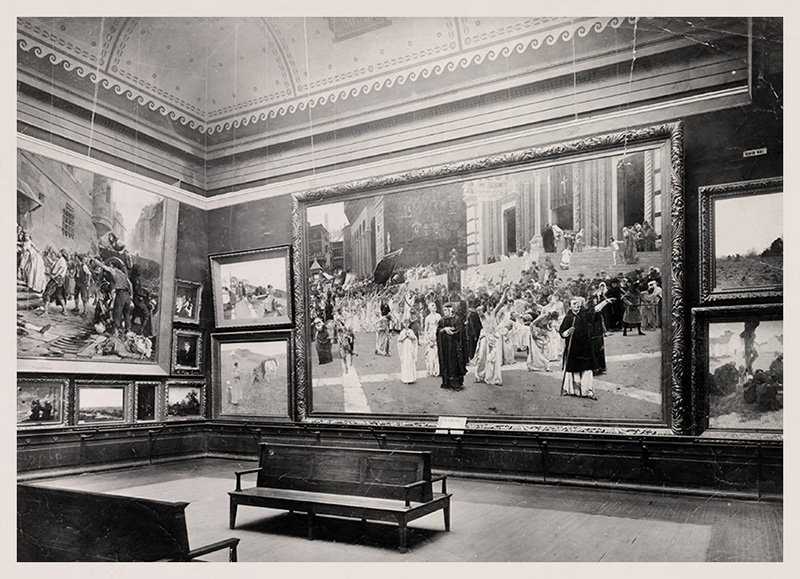





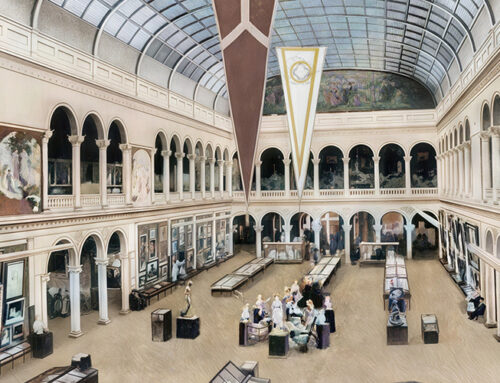
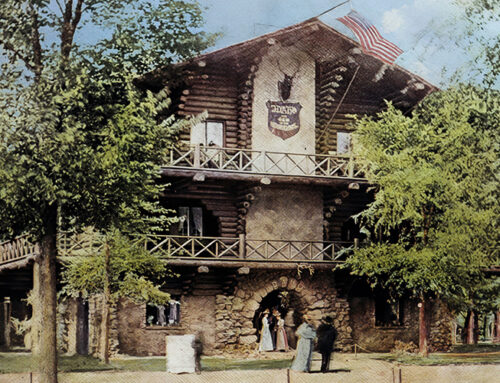
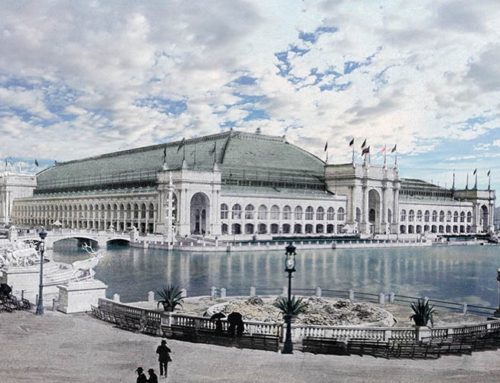
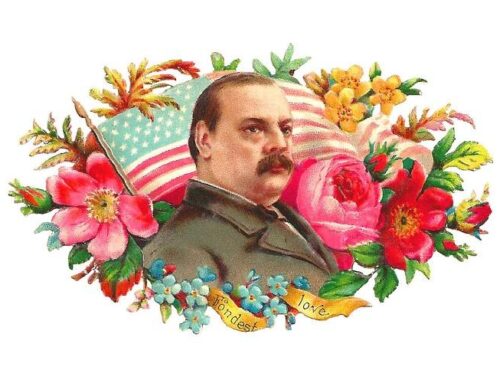
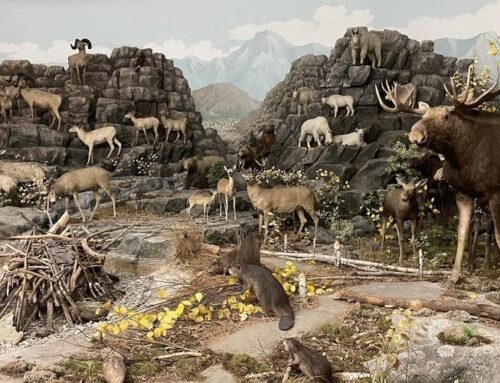
Leave A Comment